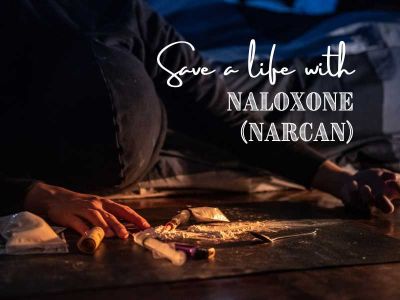Jan 17th, 2023
Drug overdoses, both fatal and nonfatal, have become an epidemic in Missouri over the past decade. It is the #1 leading cause of death among adults age 18-44 in Missouri, with most deaths (over 70%) involving opioids. For more data, visit the Missouri Department of Health & Senior Services Drug Overdose Dashboard.
The devastating impact of substance misuse and overdose places a tremendous burden on our families, communities, and healthcare systems. But, we're committed to supporting those impacted by substance misuse through this lifesaving education.
One in 47 deaths in Missouri in 2021 was due to opioid overdose. One in three people have been impacted by the opioid crisis. If you or a loved one has been impacted, help is available.
What is Naloxone?
Naloxone, also called Narcan, is a medication designed to rapidly reverse an overdose from opioids—including heroin, fentanyl, and prescription opioid medications. Simply put, it can save a life when given in time.
There are two forms of naloxone that anyone can use without medical training or authorization:
- Prefilled nasal spray: a prefilled device that sprays medication into the nose
- Injectable: a solution given by injection into a muscle or under the skin
If you or someone you know is at increased risk for opioid overdose, you should carry naloxone and keep it at home. Because you can't use naloxone on yourself, let others know you have it in case you experience an overdose. Remember, carrying naloxone is no different than carrying an EpiPen for someone with allergies—it provides an extra layer of lifesaving protection.
80% of overdose deaths occurred inside the home. And, in nearly 40% of overdose deaths, someone else was present (CDC).
When to use Naloxone?
Naloxone should be given to any person who shows signs of an opioid overdose or when an overdose is suspected. Look for these signs of overdose:
- Very small "pinpoint pupils"
- Falling asleep or unconsciousness
- Slow, shallow, or no breathing
- Choking or gurgling sounds
- Limp body (arms and legs)
- Cold and/or clammy skin
- Discolored (purple)/pale skin (especially in lips and nails)
- Vomiting
- Faint heartbeat
- Inability to speak
It may be hard to tell whether a person is high or experiencing an overdose. If you suspect someone is overdosing or aren't sure, treat it like an overdose—you could save their life with these steps:
- Call 911 immediately
- Administer Naloxone, if available
- Try to keep the person awake and breathing
- Lay the person on their side to prevent choking
- Stay with the person until emergency assistance arrives
Did you know? Missouri's Good Samaritan Law protects you and the person overdosing from arrest for possession of drugs and drug paraphernalia. Don't let fear stop you from trying to save a life.
For the best step-by-step information, see How to Respond to an Opioid Overdose from the Red Cross. Learn it, act on it—it's lifesaving information.
How to use Naloxone?
If you think someone is overdosing, call 911 immediately. Naloxone works to reverse opioid overdose in the body for only 30 to 90 minutes. But many opioids remain in the body longer than that so it is possible for a person to still experience the effects of an overdose after a dose of naloxone wears off. Also, some opioids are stronger and might require multiple doses of naloxone. For these reasons, it's important to call 911 so the individual can receive immediate medical attention.
If administering a prefilled nasal spray, spray into one nostril while the person lays on their back. This device can also be easier for loved ones and bystanders to use without formal training.
If administering an injectable, inject the vial into the person's muscle, although it may also be injected into a vein or under the skin (typically, a proper dose must be drawn from a vial).
Look for a return to normal breathing. Administering Naloxone can restore normal breathing within 2-3 minutes. Wait to see the effects of the dosage you administered and be prepared to use more than one dose if necessary. After you give someone Naloxone, stay with them until emergency help arrives or for at least 4 hours to make sure their breathing returns to normal.
Any person who asks for naloxone from a pharmacy for themselves or to help a person experiencing an opioid overdose can purchase naloxone, with or without a prescription (Missouri’s standing order).
To learn more about safer drug use and risk reduction, visit Missouri Department of Health & Senior Services MO Stays Safe. In some cases, Naloxone may be available at no cost.
With more information, comes better outcomes. Would you like to feel more comfortable using Naloxone? In most states, people who are at risk or who know someone at risk for an opioid overdose can be trained on how to give naloxone. Families can ask their pharmacists or health care provider how to use the devices.
Ultimately, we want to support those impacted by what has become a tragic epidemic in our community. Between 2020 and 2021, drug overdoses claimed more than 4,000 lives in Missouri and 30 in Cape Girardeau alone (MODHSS Drug Overdose Dashboard). Let's work together to prevent more deaths. Learning about Naloxone can help you save a life and that life might be your own.
Sources: Centers for Disease Control and Prevention (CDC), Missouri Department of Health and Human Services (MODHSS), and National Institute on Drug Abuse (NIH)
Updated: 5/23/24

